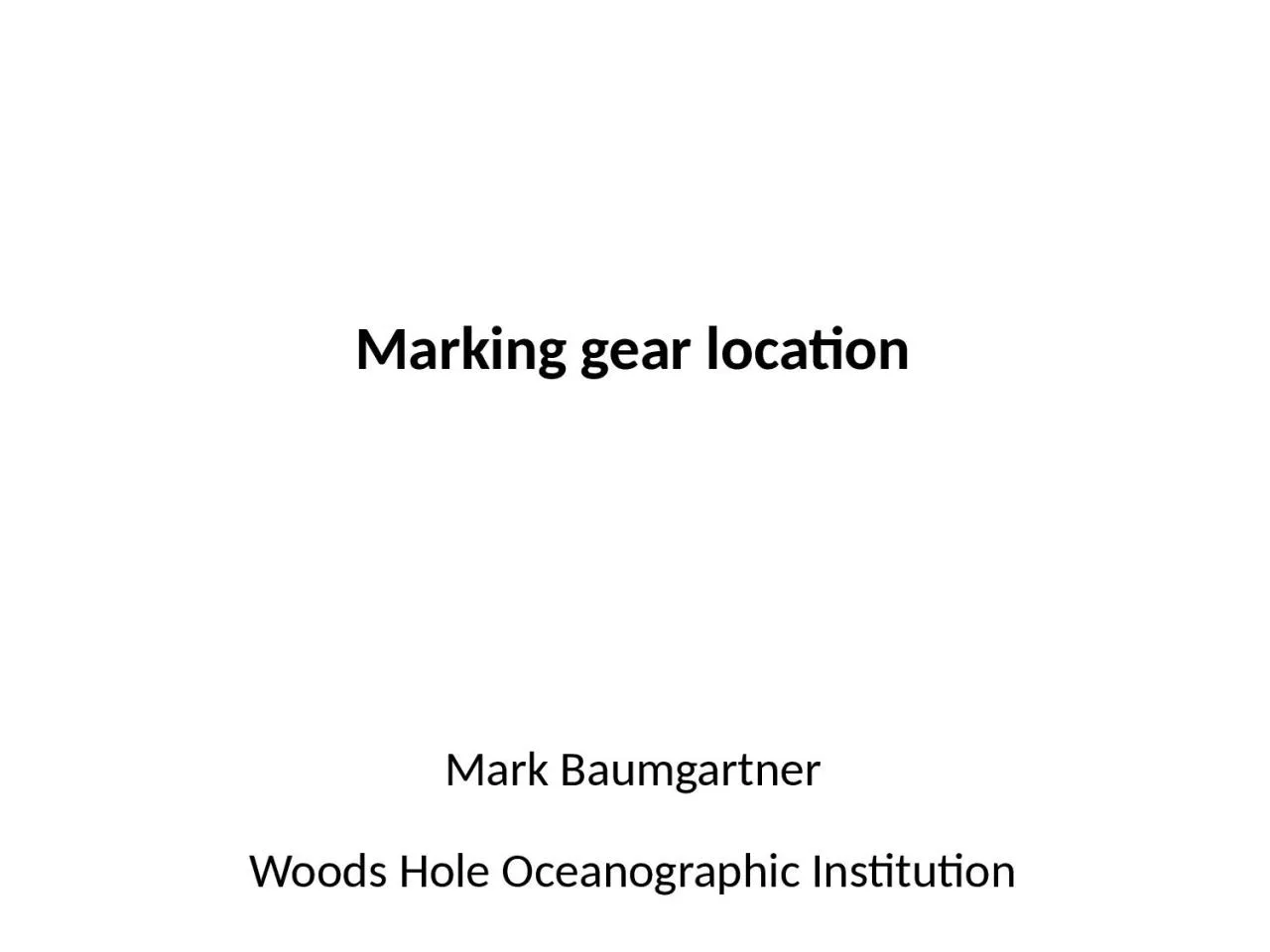

Woods Hole Oceanographic Institution Ropeless buoyless fishing Taking away the end line and buoy requires the functions of these components to be replaced Function 1 Retrieval of the gear ID: 1032734
Download Presentation The PPT/PDF document "Marking gear location Mark Baumgartner" is the property of its rightful owner. Permission is granted to download and print the materials on this web site for personal, non-commercial use only, and to display it on your personal computer provided you do not modify the materials and that you retain all copyright notices contained in the materials. By downloading content from our website, you accept the terms of this agreement.
1. Marking gear locationMark BaumgartnerWoods Hole Oceanographic Institution
2. Ropeless (buoyless) fishingTaking away the end line and buoy requires the functions of these components to be replaced:Function 1: Retrieval of the gearLift bags (variable buoyancy)Bottom-stowed ropeFunction 2: Marking the location of the gear
3. Ropeless fishing and gear conflictNMFS Concept Paper on ropeless fishing (Nov 2010):Problems with gear conflicts are the main reason why buoy lineless fisheries are not being conducted on a broad-scale basis. Any unmarked fixed gear would be susceptible to being towed through by mobile gear fisheries (bottom trawl, scallop dredge, etc.), and set over by other fixed gear and vice versa. Therefore, in order to encourage buoy lineless fishery operations, … gear conflicts would need to be addressed.
4. One approach:Have fishermen mark the location of the gear on a plotter or other system when they deploy, and then share those locations with other fishermenPros: Relatively cheap, solutions exist todayCons: (1) Fishermen are not keen to share fishing locations, (2) most fishing boats not equipped with satellite communications, (3) can be manipulated, and (4) unhelpful for gear that has moved (e.g., by a storm)
5. Acoustic approachAcoustically mark the location of each trap (singles) or the ends of each trawlEnable the trap/trawl to report its position to fixed or mobile fishermenEnable the trap/trawl to report its owner’s registration/permit information to enforcementEnable commercial chart plotters to display the positions of acoustically marked fixed gearAcoustic modems
6. Acoustic approach (continued)Pros: (1) Reports only to ships that are nearby, (2) reported locations are associated with gear that is actually on the sea floor, (3) allows recovery of gear moved after deployment (e.g., in a storm), and (4) can take advantage of acoustic communications already needed to trigger retrievalCons: Potentially expensive (at least initially)Acoustic modems
7. TechnologyAcoustic modems allow data to be passed through water via acoustical waves the way cell phone modems allow data to be passed through air via radio wavesProven technology with several commercial manufacturers: Teledyne Benthos, Nortek, EvoLogics, Sonardyne, and AquaSeNTPropose to use modems on traps and on ships to acoustically “mark” location of on-bottom gear
8. GPS satelliteconstellationTrap modem w/GPSLift bagTrap deploymentNote: trap not to scale
9. GPS satelliteconstellationTrap deployment
10. Ship with surface modem
11. Data sent from ship to trap:Date/timePosition of shipShip identifierData sent from trap to ship:Public dataLast known position of trap (GPS/ranging)Private (encrypted) dataLast surface date/timeFisherman’s registration numberUnique device identifierUser-designated identification numberSensor data (e.g., trap occupancy)
12. FishermanEnforcementRegulatorsDataWarehouseTrap modem dataData warehouse (cloud) operated byPrivate companyFisheries commissionGovernment(public and private)
13. Trap recovery
14. Gear that moves from its deployment locationLocations in the data warehouse can be used to alert fishermen of…The fact that their gear has movedThe new location of their gearSystem can greatly reduce lost gear, time spent looking for lost gear, and costsCan significantly reduce ghost gear
15. Your trawl #29 has moved. It was detected by a ship 5 hours ago at 41 18.43 N, 70 36.22 W???
16. DevelopmentAcoustic modems are commercially available, but development is required toIncorporate retrieval trigger mechanismIncorporate GPS and self-localization capabilityCommunication and data protocols to ensure interoperability (e.g., JANUS)
17. Development (continued)WHOI is working on this…Incorporated WHOI Micromodem-based trap modem in 2 retrieval systems (SMELTS lift bag, WHOI spooled rope)Will incorporate GPS this winterDeveloped methodology for self-localizationPlan to demonstrate these capabilities for fishermen and regulatorsProvide open access to methods and software
18. Development (continued)Cost depends on design and demandUnitsCost per unit1$18,00010$9,000100$4,5001,000$2,25010,000$1,125100,000$5631,000,000$281Engineering rule of thumb: As production increases by a factor of ten, cost goes down by a factor of 2WHOI trap modemCommercial acoustic modem
19. Thank you!AcknowledgementsFunding: Island FoundationLift bag: Richard Riels (SMELTS)Spooled rope: Tim Werner (NEAq)Useful discussions: Jim Partan, Keenan Ball (WHOI)Your trawl #29 has moved. It was detected by a ship 5 hours ago at 41 18.43 N, 70 36.22 W
20.